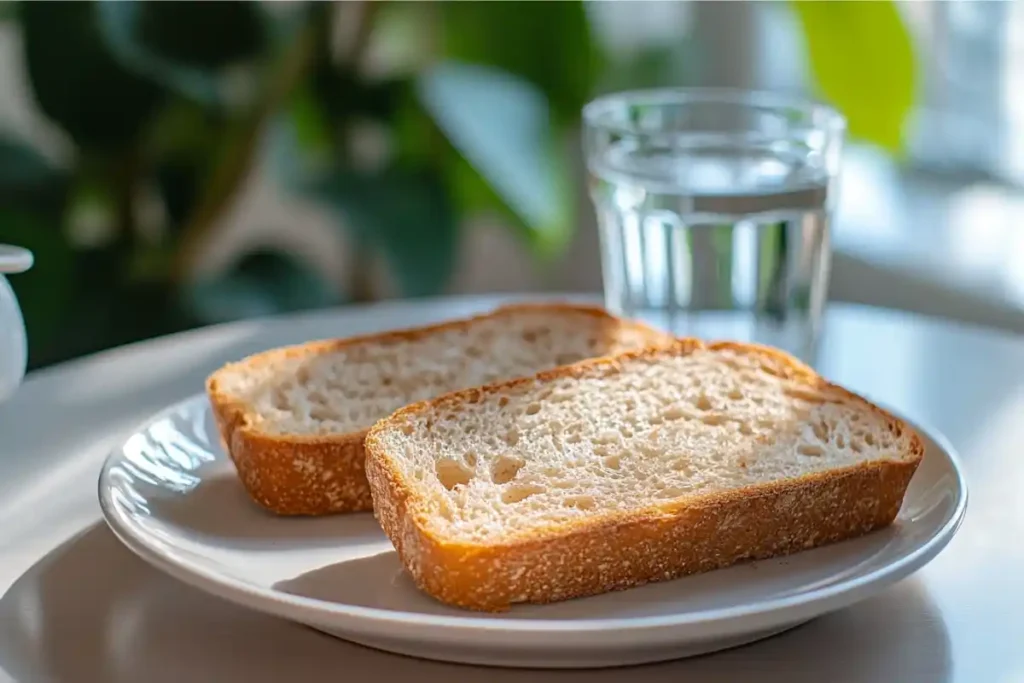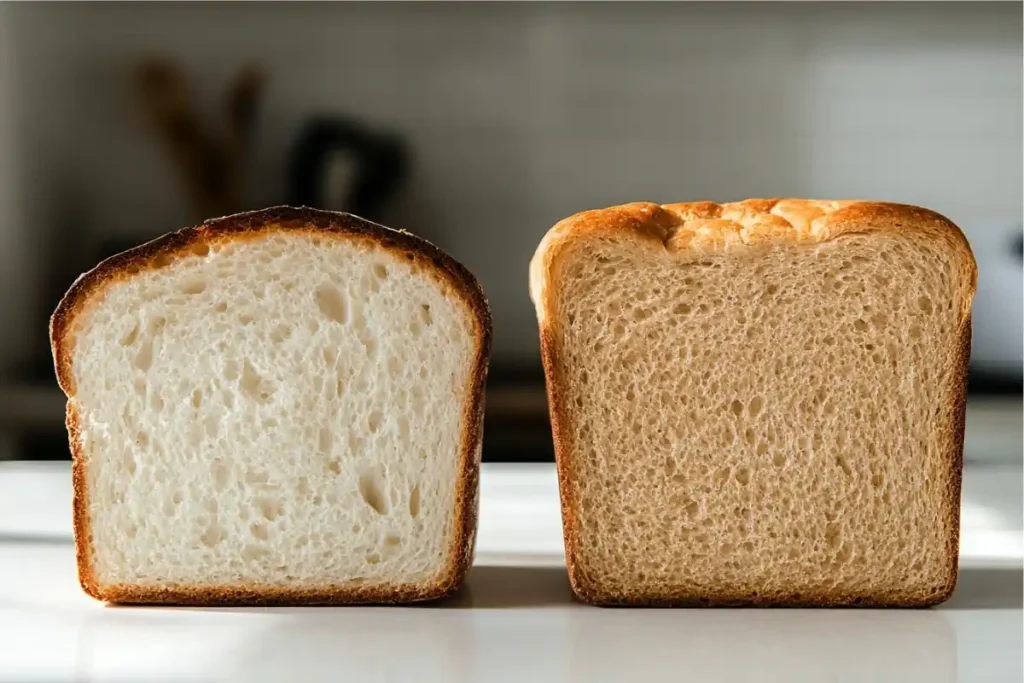Sourdough bread has long received praise for its tangy taste, homemade feel, and health perks. But this bread isn’t flawless, and it’s important to look at its downsides too. In this article, we’ll look at sourdough bread’s disadvantages, like its nutrition gaps, digestion problems, and price issues. By the end, you’ll know if sourdough bread is right for you.
Let’s start by looking at its nutrition issues.
Nutritional Drawbacks of Sourdough Bread
Lower Fiber Content Compared to Whole-Grain Breads

One of the biggest disadvantages of sourdough bread is its lower fiber content compared to whole-grain breads. Most traditional sourdough recipes rely on refined flour, which lacks the bran and germ present in whole grains. This makes sourdough less effective for improving digestion and maintaining heart health.
Fiber is key for healthy digestion, regular bowel movements, and steady blood sugar levels. Whole-grain bread naturally has more fiber, helping you feel full longer and lowering cholesterol. On the other hand, sourdough made with white flour doesn’t provide as many of these benefits. If you want more fiber, pick sourdough made with whole-grain flour instead.
Higher Blood Sugar Spikes with White Flour
The way sourdough ferments helps keep its glycemic index lower than plain white bread but don’t let that fool you—it can still raise your blood sugar quickly. Refined flour in most sourdough recipes releases carbs into your bloodstream fast, causing sugar levels to jump.
Whole-grain bread slows down how your body absorbs carbs, which keeps blood sugar steadier. In contrast, sourdough made with white flour may cause trouble for people with diabetes or insulin problems. While fermentation lowers the risk a little, it doesn’t completely stop sugar swings.
Sourdough bread may taste great and feel easier to digest, but its low fiber and blood sugar issues are things to consider. Next, we’ll see how it can cause problems for people with allergies or sensitivities.
Allergies and Digestive Issues
Not Gluten-Free: A Risk for Celiac Disease Patients
For those with celiac disease, one of the key disadvantages of sourdough bread is its gluten content. Although fermentation breaks down some gluten, sourdough still contains enough to make it unsafe for individuals with gluten intolerance or allergies.
Some people think sourdough is gluten-free because it’s easier to digest. However, while fermentation makes gluten easier for some people to handle, it doesn’t remove it. For a truly gluten-free option, choose bread labeled and certified as gluten-free.
Sensitivity to FODMAPs in Certain Populations
The fermentation process in sourdough can reduce FODMAPs, but for sensitive individuals, they may still trigger discomfort. This highlights another of the disadvantages of sourdough bread—it may not be suitable for everyone, even if it’s easier to digest for some.
People on a low-FODMAP diet often need to avoid sourdough or eat it in very small amounts. If you’re unsure how it affects you, try a small portion and see how your body reacts.
Accessibility and Cost Challenges
Time and Skill Needed for Homemade Sourdough
Making sourdough bread at home can be fun, but it’s not easy. To bake sourdough from scratch, you need patience, time, and some baking know-how. Growing a sourdough starter alone takes days and needs regular care to keep it alive.
If you’re new to baking, the process can feel tough, from mixing the dough to managing long wait times. While sourdough starter kits can make it easier, they still take effort and focus. For those short on time, buying sourdough from a store might seem like the best option.
Learn how to make sourdough garlic bread for easy recipes that are beginner-friendly.
Big Price Difference: Artisanal vs. Mass-Produced Sourdough
Store-bought sourdough bread is convenient, but not all loaves are the same. Artisanal sourdough bread, loved for its great taste and quality, often costs much more. Many bakeries spend extra time making it, which explains the higher price.
Mass-produced sourdough, on the other hand, may skip the slow fermentation process to save time and money. These loaves are cheaper, but they might have added chemicals or preservatives that lower the quality. For true sourdough fans, deciding between price and quality can be hard.
For affordable sourdough ideas, check out this sourdough bread bowl recipe for fun ways to make the most of your bread.
Additives and Quality Issues in Store-Bought Sourdough
Additives in Mass-Produced Sourdough Bread

One of the less obvious disadvantages of sourdough bread is found in mass-produced versions. These often include additives, preservatives, and artificial flavors to improve shelf life, which can diminish its natural health benefits. Choosing homemade or artisanal sourdough is often a better option.
Some companies even add vinegar or other acids to copy the tangy flavor made through long fermentation. This shortcut saves time but lowers the bread’s quality. Buying fresh, artisanal sourdough from a bakery is a better way to avoid these additives.
If you want to boost the flavor of sourdough, check out this guide to making sourdough garlic bread.
Shortened Fermentation Process and Nutrient Loss
Another issue with store-bought sourdough is that it ferments for less time. Traditional sourdough takes hours or even days to fully ferment, allowing healthy bacteria to break down gluten and make the bread easier to digest. But commercial bread makers often speed up this process to save time, which lowers the health benefits.
This quicker fermentation also affects the bread’s taste and texture, making it less tangy and more plain. If you want sourdough with all its nutritional and flavor perks, try baking it at home or buying from small bakeries.
Environmental and Ethical Concerns
Environmental Impact of Commercial Production
Another downside of sourdough bread, especially the mass-produced kind, is its effect on the environment. Big factories often use lots of energy, create packaging waste, and contribute to air pollution during transportation. These problems cancel out the eco-friendly benefits of buying from local bakers.
Choosing local bakeries or baking sourdough at home can lower your carbon footprint. Homemade sourdough cuts out packaging and reduces shipping emissions, making it a more environmentally friendly option.
Ethical Considerations in Sourcing Ingredients
There are also ethical problems with how elements for sourdough bread is sourced. Many big companies focus on cutting costs, which means they use wheat grown with harmful chemicals or through unfair labor practices. Picking organic or sustainably farmed wheat helps support farmers and makes your bread better for the planet.
If you want more earth-friendly bread recipes, take a look at this sourdough bread bowl guide for creative ways to enjoy sourdough.
Sourdough bread has a special flavor and health benefits, but mass production and ethical issues can take away from its good points. When choosing bread, think about these factors to find the best option for your health and the planet.
Weighing the Benefits and Drawbacks
Balancing Health Benefits with Potential Issues

While sourdough offers benefits, such as improved digestion and unique flavor, it’s crucial to weigh these against the disadvantages of sourdough bread. For instance, the lower fiber content, gluten presence, and potential additives in commercial loaves are all factors to consider when deciding if it’s the right choice for you.
For example, sourdough doesn’t have as much fiber as whole-grain bread, which makes it less helpful for digestion and heart health. Also, store-bought sourdough often includes extra ingredients that lower its health value compared to fresh or homemade options.
Even with these problems, sourdough still has benefits like being easier to digest for some people and causing smaller blood sugar spikes than white bread. To make the best choice, think about your health goals. If you need more fiber, pick whole-grain sourdough. If quality matters most, choose fresh bakery bread or make it at home.
Tips for Picking the Best Sourdough
To enjoy sourdough without the problems, check the ingredients. Look for simple ones like flour, water, and salt, and avoid breads with preservatives or added flavors. If possible, buy from local bakers or bake your own for the best results.
Starter kits can help beginners make high-quality bread at home. Homemade sourdough not only tastes better but also lets you control what goes into it.
FAQs About Sourdough Bread
Is Sourdough Bread Good for Everyone?
No, sourdough isn’t good for everyone. People with celiac disease or strong gluten sensitivities should avoid it because it still has gluten. For others with mild sensitivities, sourdough might be easier to digest.
Does Sourdough Keep Blood Sugar Levels Stable?
Sourdough’s fermentation can help lower blood sugar spikes compared to white bread. But it’s not a low-carb choice and can still raise blood sugar, especially in people with diabetes.
Is Sourdough Better Than Whole-Grain Bread?
This depends on what you need. Sourdough is easier to digest and causes smaller blood sugar spikes, but it doesn’t have as much fiber as whole-grain bread. Whole-grain sourdough can give you the best of both.
Can I Make Sourdough at Home?
Yes! Baking sourdough at home can be fun to enjoy its full benefits without extra ingredients or shortcuts. While it takes time, starter kits and guides can simplify the process.
Sourdough bread adds variety to your diet, but it does have drawbacks. By learning the disadvantages of sourdough bread, you can make smarter choices that fit your needs. Whether you buy from a bakery or bake your own, sourdough is a tasty option when chosen wisely.
Clearing Up Myths About Sourdough Bread
Is Sourdough Bread Good for Every Diet?
Many people think sourdough bread works for every diet, but this isn’t entirely true. One big question often asked is: What is the disadvantage of sourdough bread? The answer often relates to its gluten content. Even though the fermentation process breaks down some gluten, sourdough still has enough to make it unsafe for those with celiac disease or strong gluten sensitivities.
For people following a low-carb diet, sourdough might not be the best choice either. While fermentation lowers its glycemic index, sourdough is still high in carbs and can raise blood sugar. Knowing these limits is important before adding it to your meals.
Is Sourdough Bread Always Better?
Another common myth is that sourdough bread is always healthier than other kinds of bread. Sourdough has benefits, like being easier to digest and made through a natural process, but not all sourdough is equal. Mass-produced sourdough often includes extra ingredients and doesn’t have the same nutrition as homemade or bakery bread.
Whole-grain bread has more fiber, and gluten-free options are better for those with restrictions. Sourdough is a great option for many, but comparing it with other bread types helps you pick what’s right for you.
Making Smart Choices About Sourdough Bread
Final Thoughts on Sourdough Bread
Understanding the disadvantages of sourdough bread—including its gluten content, low fiber levels, and reliance on refined flour—allows you to make better decisions about how and when to enjoy it. Whether you bake your own, buy fresh from a bakery, or explore other bread types, knowing the potential drawbacks is key to fitting sourdough into a balanced diet.
Making sourdough at home gives you control over what’s in it, letting you make a cleaner and healthier loaf. If you don’t want to bake, local bakeries are a good place to buy fresh sourdough made with simple ingredients.
Final Thoughts on Sourdough Bread
While sourdough bread has many fans, it’s important to understand its downsides. Asking questions like What is the disadvantage of sourdough bread? helps you spot issues like gluten content, low fiber levels, or added ingredients in store-bought bread.
By knowing these factors, you can make better choices about when to eat sourdough. Whether you make it at home, buy bakery-fresh loaves, or try other breads, the key is to find what suits your diet and lifestyle best.


